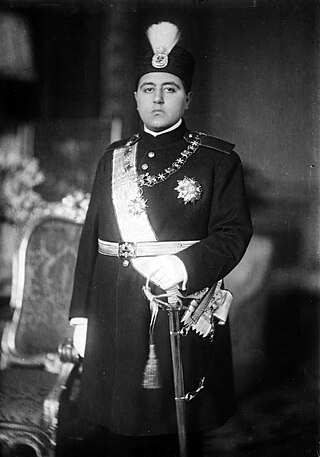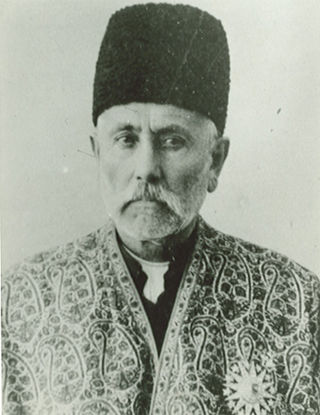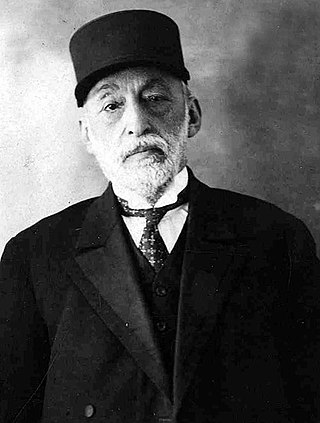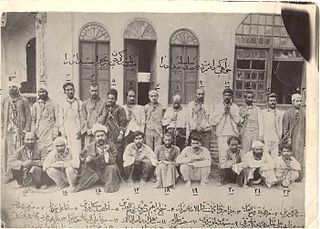
Ahmad Shah Qajar was Shah of Persia (Iran) from 16 July 1909 to 15 December 1925, and the last ruling member of the Qajar dynasty.

Mohammad Ali Shah Qajar Shah of Iran from 8 January 1907 to 16 July 1909. He was the sixth shah of the Qajar dynasty.

Mozaffar ad-Din Shah Qajar, was the fifth Qajar shah (king) of Iran, reigning from 1896 until his death in 1907. He is often credited with the creation of the Persian Constitution of 1906, which he approved of as one of his final actions as shah.

Sattar Khan, honorarily titled Sardār-e Melli was a pivotal figure in the Iranian Constitutional Revolution and is considered a national hero by the Iranian people.

Dār ul-Funun is the oldest Western-style institute of higher education in Iran, established by the royal vizier to Nasereddin Shah in 1851.

Prince Iraj Mirza, son of prince Gholam-Hossein Mirza, was a famous Iranian poet. He was a modern poet and his works are associated with the criticism of traditions. He also made translation of literary works from French into Persian.

Hezardastan also known as Hezar Dastan, was an Iranian epic historical drama television series from 1987, developed and directed by Ali Hatami. Hezar Dastan is considered one of the most important and most influential works of art in the history of Islamic Republic of Iran Broadcasting. The show's story, characters, acting, style, and music were highly acclaimed by critics and fellow directors of the time, and the influence of the show's themes and story can be seen in Iranian popular culture as well as many works of art coming in later years.

Mirzā Jahāngir Khān, also known as Mirzā Jahāngir Khān Shirāzi and Jahāngir-Khān-e Sūr-e-Esrāfil, was an Iranian writer and intellectual, and a revolutionary during the Iranian Constitutional Revolution (1905–1911). He is best known for his editorship of the progressive weekly newspaper Sur-e Esrāfil, of which he was also the founder. He was executed, at the age of 38, or 32, for his revolutionary zeal, following the successful coup d'état of Mohammad-Ali Shah Qajar in June 1908. His execution took place in Bāgh-e Shāh in Tehran, and was attended by Mohammad-Ali Shah himself. He shared this fate simultaneously with his fellow revolutionary Mirzā Nasro'llah Beheshti, better known as Malek al-Motakallemin. It has been reported that immediately before his execution he had said "Long live the constitutional government" and pointed to the ground and uttered the words "O Land, we are [being] killed for the sake of your preservation [/protection]".

The Persian Constitutional Revolution, also known as the Constitutional Revolution of Iran, took place between 1905 and 1911 during the Qajar dynasty. The revolution led to the establishment of a parliament in Persia (Iran), and has been called an "epoch-making episode in the modern history of Persia".

Kamran Mirza was a Persian Prince of Qajar dynasty and third surviving son of Nasser al-Din Shah. He was the brother of Mass'oud Mirza Zell-e Soltan and Mozzafar al-Din Shah. Kamran Mirza also served as Iran's Commander-in-Chief, appointed in 1868 for the first time, and minister of war from 1880 to 1896 and from 1906 to 1907.

Mirza Seyyed Mohammad Tabatabai was one of the leaders of the Iranian Constitutional Revolution who played an important role in the establishment of democracy and rule of law in Iran. He was the son of Sayyed Sādegh Tabātabā'i, one of the influential Scholar during the reign of Naser ad-Din Shah Qajar. His paternal grandfather, Sayyed Mehdi Tabātabā'i, was a reputed clergy in Hamedan. He is the father of Sayyed Sādegh Tabātabā'i editor of Ruznāmeh-ye Majles, the Majles newspaper.

Najaf-Qoli Khan Bakhtiari also known Saad al-Dowleh and Samsam al-Saltane (1846–1930), was a Persian Prime Minister and a leader of the Iranian Constitutional Revolution. He was elected Prime Minister for two terms, first from 3 May 1909 to 16 July 1909 and again from 23 December 1912 to 17 January 1913, when he resigned from the office. He was a representative of Parliament of Iran from Tehran in the 4th Parliament. He was the older brother of Ali-Qoli Khan Bakhtiari, better known as Sardar Assad, Bibi Maryam Bakhtiari and Khosrou Khan, Sardar Zafar Bakhtiari. He died in 1930 in Isfahan.

Mehdi Qoli Khan Hedayat, also known as Mokhber-ol Saltaneh, was Prime Minister of Iran and an author of several books on Iranian music, modern education, poetry, current affairs, and most notably a memoir covering his political tenure under the last 6 kings of Iran.

The 1908 bombardment of the Majlis of Iran took place on 23 June 1908 in Tehran, during the Iranian Constitutional Revolution, when the Persian Cossack forces, commanded by Vladimir Liakhov and other Russian officers, bombarded and suppressed the Iranian parliament, the Majlis.

Amanollah Khan Zia' os-Soltan was an Iranian aristocrat and politician at Qajar court during the time of Mozaffar ad-Din Shah, Mohammad Ali Shah and Ahmad Shah Qajar and hero of the Persian Constitutional Revolution.

Qajar Iran, also referred to as Qajar Persia, the Qajar Empire, Sublime State of Persia, officially the Sublime State of Iran and also known as the Guarded Domains of Iran, was an Iranian state ruled by the Qajar dynasty, which was of Turkic origin, specifically from the Qajar tribe, from 1789 to 1925. The Qajar family took full control of Iran in 1794, deposing Lotf 'Ali Khan, the last Shah of the Zand dynasty, and re-asserted Iranian sovereignty over large parts of the Caucasus. In 1796, Agha Mohammad Khan Qajar seized Mashhad with ease, putting an end to the Afsharid dynasty. He was formally crowned as Shah after his punitive campaign against Iran's Georgian subjects.

Seyyed Abdollah Behbahani was a Shi'a theologian and a prominent leader of the constitutional movement. He was born in Najaf and was educated by scholars such as Morteza Ansari. During the constitutional movement he was influential in the Majlis. On the night of 15 July 1910, four gunmen attacked his house and killed him. Seyyed Hassan Taghizadeh was suspected to be responsible, and he subsequently fled the country.

The Iranian Enlightenment, sometimes called the first generation of intellectual movements in Iran, brought new ideas into traditional Iranian society from the mid-nineteenth to the early twentieth century. During the rule of the Qajar dynasty, and especially after the defeat of Iran in its war with the Russian Empire, cultural exchanges led to the formation of new ideas among the educated class of Iran.The establishment of Dar ul-Fonun, the first modern university in Iran and the arrival of foreign professors, caused the thoughts of European thinkers to enter Iran, followed by the first signs of enlightenment and intellectual movements in Iran.

The Imperial Russian involvement in the Persian Constitutional Revolution was to support the authoritarian faction led by Mohammad Ali Shah to defeat the constitutionalists. Until 20 April 1909, when the Russian army under Major General I. Snarsky occupied Tabriz to protect the Russian consuls, the Russian Empire indirectly supported Ali Shah and the authoritarian faction. Support from the Russian Empire included sending weapons, lending money to Colonel Vladimir Liakhov, the commander of the Persian Cossack Brigade, and a large-scale propaganda machine against the constitutionalist leaders.

The Minor Tyranny was a roughly one year long period in Iranian history lasting from the bombardment of the Iranian parliament by the forces of Mohammad Ali Shah on 23 June 1908 to the capture of Tehran by the revolutionary forces on 13 July 1909. This period was marked by the executions and expulsion of many journalists and constitutionalists as an era of absolutism returned to the country.




















